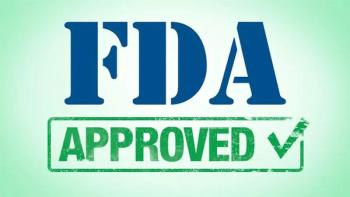
Frontline Epcoritamab/R-CHOP Combination Induces 100% ORR in Patients With High-Risk DLBCL
Data from the phase 1/2 EPCORE NHL-2 trial suggest that the combination of epcoritamab and R-CHOP is both effective and manageable in treating patients with high-risk diffuse large B-cell lymphoma.
High overall response rates and complete metabolic response (CMR) rates were observed among patients with high-risk diffuse large B-cell lymphoma (DLBCL) who received frontline treatment with subcutaneous epcoritamab and R-CHOP, according to data from arm 1 of the phase 1/2 EPCORE NHL-2 trial (NCT04663347) presented during the 2022 EHA Congress.1 Moreover, the combination was associated with a manageable safety profile.
At a median follow-up of 6.9 months (range, 0.8-14.7), the combination regimen induced an ORR of 100% among 33 patients. Moreover, the combination resulted in a CMR rate of 77% and a partial metabolic response rate of 23%.
“Epcoritamab plus R-CHOP showed encouraging responses…[and] a manageable safety profile, [and] no new safety signals were detected,” Michael Roost Clausen, MD, PhD, of Vejle Hospital, and colleagues, wrote in a poster on the data. “These updated data support further exploration of epcoritamab plus R-CHOP in [patients with] first-line DLBCL.”
Patients with DLBCL and 3 to 5 risk factors are known to have poor outcomes with standard frontline R-CHOP (rituximab [Rituxan] plus cyclophosphamide, doxorubicin hydrochloride, vincristine, and prednisone); these patients have an overall survival rate of 55% at 4 years. As such, novel therapeutic approaches are needed for this population.
Epcoritamab binds to CD3 on T cells and CD20 on B cells to elicit the T-cell–mediated killing of CD20-positive, malignant B cells. When used in combination with R-CHOP, epcoritamab-mediated T-cell cytotoxicity is maintained, according to the study investigators.
Previously, data from the dose-escalation portion of the phase 1/2 EPCORE NHL-1 trial (NCT03625037) showed that epcoritamab monotherapy had an acceptable toxicity profile with strong antitumor activity in patients with heavily pretreated B-cell non-Hodgkin lymphoma.2
The agent elicited an ORR of 68% (95% CI, 45%-86%) in patients with relapsed/refractory DLBCL, which included a CR rate of 45% when given at full doses ranging from 12 mg to 60 mg. When administered at 48 mg, epcoritamab produced an ORR of 88% (95% CI, 47%-100%), with a CR rate of 38%. In patients with relapsed/refractory follicular lymphoma, epcoritamab induced an ORR of 90% (95% CI, 55%-100%), with a CR rate of 50% when given at full doses of 0.76 mg to 48 mg.
Arm 1 of the open-label, multicenter EPCORE NHL-2 trial was comprised of patients with newly diagnosed, CD20-positive DLBCL, an International Prognostic Index (IPI) score of 3 or greater, an ECOG performance status of 0 to 2, measurable disease, and acceptable organ function.
The dose-escalation portion of the trial included 10 patients. Subcutaneous epcoritamab was given at 24 mg (n = 4) or 48 mg (n = 6) given weekly for cycles 1 through 4, every 3 weeks for cycles 5 and 6, and every 4 weeks for cycle 7 and on. R-CHOP was also administered in cycles 1 through 6. The primary objectives were dose-limiting toxicities, safety, and tolerability.
A total of 23 patients were included in the dose-expansion phase of the trial. Here, patients received subcutaneous epcoritamab at 48 mg every week for cycles 1 to 4, every 3 weeks for cycles 5 and 6, and every 4 weeks for cycle 7 and on, in combination with R-CHOP for cycles 1 through 6. The primary objective of this portion of the research was antitumor activity.
Among the 33 patients evaluated, the median age was 66 years (range, 19-82), 55% were male, 48% had an ECOG performance status of 1, 79% had Ann Arbor stage IV disease, 55% had an IPI score of 3, and 85% had de novo disease. The median time from diagnosis to first dose of treatment was 26 days (range, 5-70).
At a data cutoff date of March 25, 2022, 73% of the 33 patients were still receiving treatment with the combination and 18% had discontinued the regimen. Reasons for discontinuation included disease progression (6%), toxicity (3%), or another unspecified reason (9%). Three patients had completed treatment.
The median number of epcoritamab cycles initiated was 9 (range, 1-15), and the median duration of treatment was 6.3 months (range, 0.6-11.5). Fifty-two percent of patients required a dose delay of epcoritamab because of a treatment-emergent adverse effect (TEAE). Moreover, 91% of patients completed 6 cycles of R-CHOP.
Regarding safety, the most common TEAEs included anemia (grade 1/2, 33%; grade 3, 27%), neutropenia (grade 1/2, 6%; grade 3, 9%), cytokine release syndrome (grade 1/2, 48%; grade 3, 3%), nausea (grade 1/2, 45%), injection-site reaction (grade 1/2, 42%), constipation (grade 1/2, 33%; grade 3, 3%), fatigue (grade 1/2, 36%), peripheral sensory neuropathy (grade 1/2, 33%), pyrexia (grade 1/2, 33%), peripheral edema (grade 1/2, 27%), cough (grade 1/2, 21%), diarrhea (grade 1/2, 18%; grade 3, 3%), dyspnea (grade 1/2, 18%), headache (grade 1/2, 21%), and thrombocytopenia (grade 1/2, 12%; grade 3, 9%). Forty-five percent of patients experienced grade 4 neutropenia, and 3% experienced grade 4 dyspnea.
No events of tumor lysis syndrome were reported, although 1 patient experienced grade 2 immune effector cell–associated neurotoxicity syndrome, which resolved in 4 days.
Seventeen of the 33 patients experienced CRS; 27% of patients experienced a grade 1 event, 21% experienced a grade 2 event, and 3% experienced grade 3 CRS. All these cases were resolved, with a mean of 2 days to resolution (range, 1-11). No patients discontinued treatment due to CRS. Fifteen percent of these patients received tocilizumab (Actemra).
“CRS was mostly low grade, and all cases resolved, the study authors wrote. “CRS occurrence was predictable; most cases occurred following the first full dose with a median time to onset of 2 days.”
References
- Clausen MR, Offner F, Belada D, et al. Subcutaneous epcoritamab + R-CHOP for first-line treatment of patients with high-risk diffuse large B-cell lymphoma: phase 1/2 update. Presented at: 2022 EHA Congress; June 9-12, 2022; Vienna, Austria. Abstract P1214.
- Hutchings M, Mous R, Clausen MR, et al. Dose escalation of subcutaneous epcoritamab in patients with relapsed or refractory B-cell non-Hodgkin lymphoma: an open-label, phase 1/2 study. Lancet. 2021;398(10306):1157-1169. doi:10.1016/S0140-6736(21)00889-8
Newsletter
Knowledge is power. Don’t miss the most recent breakthroughs in cancer care.































































































